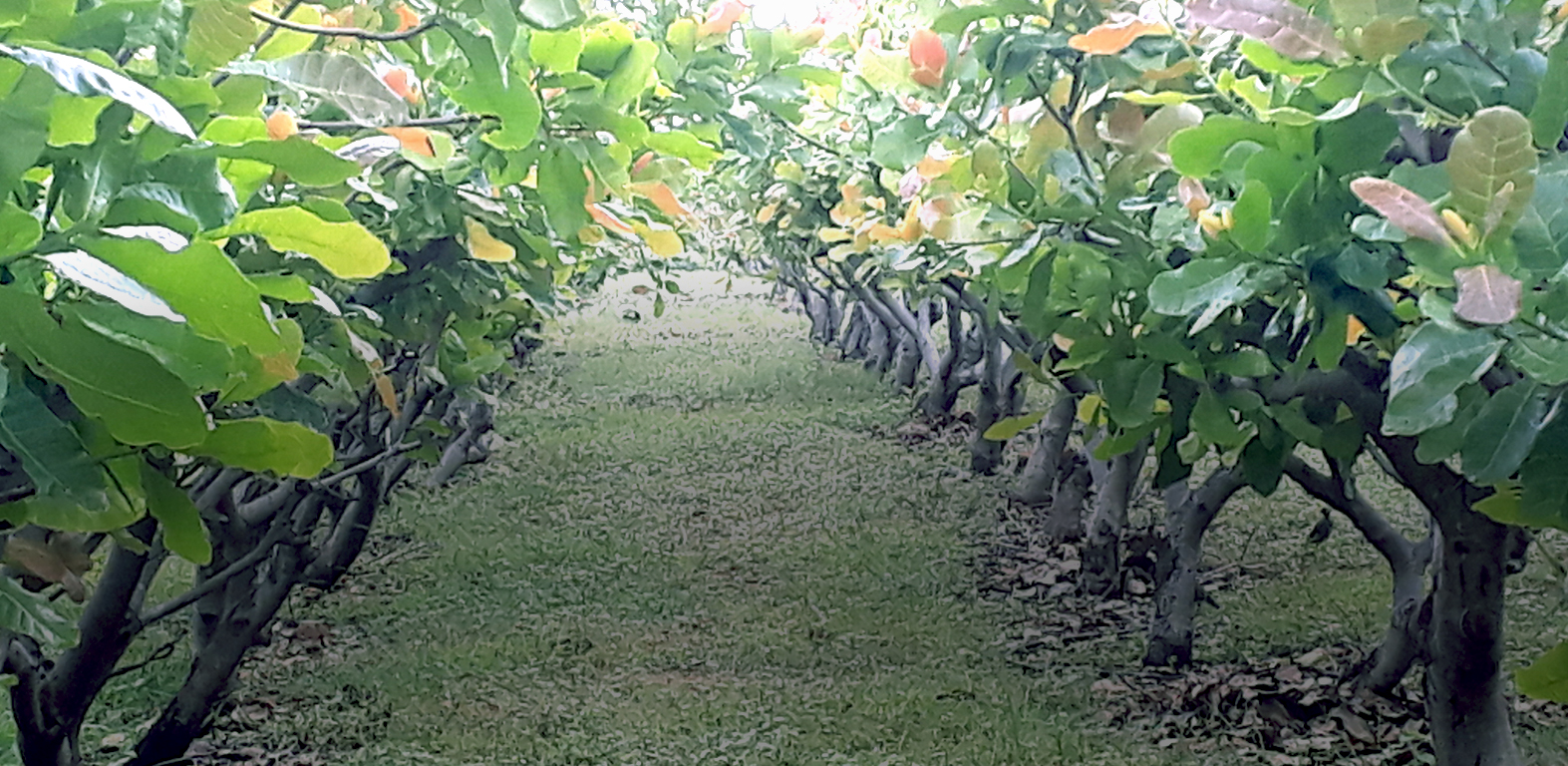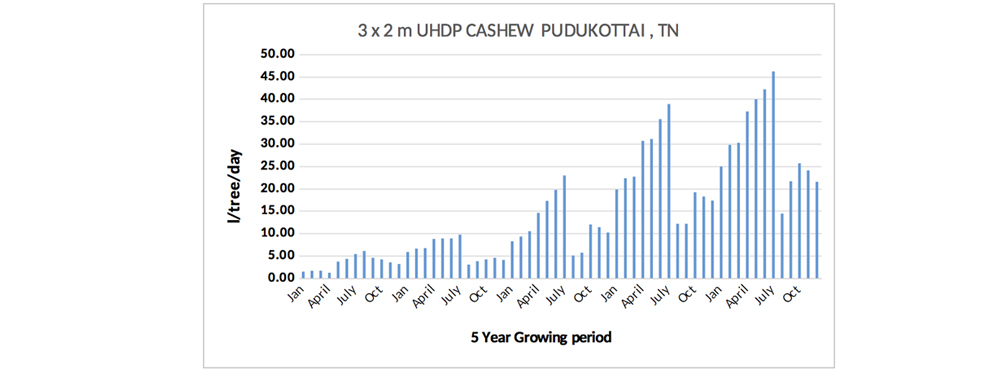Welcome to Jain Irrigation Systems Ltd.

Blog at Jains - HOW MUCH WATER DOES MY CROP NEED? Part II. Perennial crops, 2. Cashew
Cashew is one of the most neglected high value crop. Introduced to India as the tree for soil conservation to prevent soil from erosion, its produce, cashew nut is a high value commodity. However, Cashew remained a neglected crop for crop improvement and management techniques. We at Jain R& D have worked on cashew and demonstrated that, the trees when planted at very close spacing, and manage the canopy by training and pruning and nurture through drip fertigation will yield early in their life and yield very high. One of major input in such high and ultrahigh density orchards is irrigation through drip. Hence the water requirement, ETP, estimation becomes critical.
Irrigation ‘water need’ of perennials is specifically impacted by the fact that they repeat development processes every year. The water need varies with age (no of years), size (canopy cover) in a more dramatic way than they affect water need of annual or seasonal crops.
1. The major difference of perennials is that their life cycle repeats year after year producing fruits annually once or sometimes two times or continually once fruiting starts.
2. Like Mango, Cashew also has a pre-flowering stage in high density plantation. But the period is much short compared to the conventional plantation.
3. Cashew also require a total dry period every year prior to flowering.
4. Another factor that affect the water need is the management of the canopies by training and pruning (technology interventions).
5. Crop geometry (Row and tree spacing) also affects the water requirement.
Cashew (Anacardium occidentale), a native of Brazil, was introduced in India during the latter half of the 16th century for the purpose of afforestation and soil conservation. Cashew has now emerged as a major foreign exchange earner next only to tea and coffee.
Commercial cultivation of cashew is taken up in eight states in India. It is also cultivated on small areas in other states of the country. India has an area of about 9.53 lakh ha under cashew with an estimated annual production of about 6.74 lakh tonnes of raw cashew nut. India is the largest producer, processor, consumer and exporter of cashew in the world. The current production accounts for 45% of the global production. Coastal states of the country are the main production centres. The important cashew growing states of India are Andhra Pradesh, Goa, Karnataka, Kerala, Maharashtra, Orissa and Tamil Nadu.
There is a short fall of cashew requirement to feed the processing plants and the country imports raw cashew.
Cashew cultivation is taken up in small and marginal holdings and as more than 70% of the cashew area is under this category, cashew plays an important role in the development of small and marginal farmers. Certainly cashew production has to increase. To begin with, the productivity has to increase. Other options can be to plant more in waste or un- utilized land in the cashew growing states and extend to other states.
Jain Irrigation introduced a game changing field technology where Cashew grafts are planted at 3 m x 2m spacing to obtain 1667 trees/ha and manged them with drip fertigation input technologies and strict canopy maintaining methods. The UHDP cashew produced about a ton cashew nuts per acre in the 3rd year of growth. The productivity enhancement obtained in UHDP has been attracting large number of growers.
Climatic Requirement of Cashew
• Cashew is a tropical plant and thrives in high temperatures.
• Young plants are sensitive to frost.
• Areas where temperature ranges from 20 to 30 degree Celsius with an annual precipitation of 1000 - 2000 mm are ideal for cashew growing.
• Heavy rainfall, evenly distributed throughout the year, is not favourable though the trees may grow and some times set fruit.
• It needs a climate with a well defined dry season of at least four months to produce the best yields. Coincidence of excessive rainfall and high relative humidity with flowering may result in flower/fruit drop and heavy incidence of fungal disease.
• Cashew is regarded as "essentially coastal tree" but that is not true. It also grows well at considerable distance from the coast.
I have estimated the water need of Cashew, in both conventional geometry (8 x 8 m; 156 trees/ha) and UHDP (3 x 2 m; 1667 trees/ha). In the conventional orchard, first flowering occurs by the end of 5th or 6th year, while in UHDP it occurs by the end of 3rd year. No hard pruning or any pruning is done in the conventional system while a training is done at the 3rd month of planting (approximately at 75 cm tall) and pruning of the canopy to maintain the trees in relation to the space they are given is done every year in UHDP. These practices would affect the daily water requirement as they cause variation in the canopy (ground cover).
Cashew crop normally ends in April. In areas where North East monsoon occurs, if flowering time is allowed to set in the normal growth cycle, fruit formation occurs after October when there is frequent rain. In UHDP, (in Tamil Nad) we suggest to prune the trees in August, and get the flowering and fruiting pushed to the end of the rainy season. In this case, because of intermittent rain, no continuous stress period can be imposed.
Water for Cashew
Estimate of water use by the crop is becoming a necessity as the water availability is shrinking and it is known that Cashew does not like excess soil moisture at any time of their growth. Growers are also looking for opportunities to improve water productivity, by conserving water or reducing its consumption. At this point one start asking "How much water does my crop need?
Moisture stress affects the growth and development of the plant especially during the post pruning vegetative and fruit growth stages. Drip irrigation is proved to be ideal for mango and the water requirement is precisely estimated.
Fig 1. Water requirement (ETP) estimated for drip method of irrigation of UHDP Cashew orchard for 5 year growth period. Fruiting is expected at 3rd year transition. (Pudukottai, TN)

Fig 2. Water requirement (ETP) estimated for drip method of irrigation of UHDP (3x 2m) and Conventional (8 mx 8m) orchards for 5 year growth period. Fruiting is expected at 3rd year. (Pudukottai dist. , TN)

Where does all the water go after one irrigates a crop field? Water moves out of the field in 7 different ways after an irrigation that floods the field: 1.Direct evaporation from the water surface, 2. Drift of water away from the field due to wind, 3. Transpiration through the body of the crop plant (Mainly thru leaves), 4. Evaporation from the wet ground exposed to the atmosphere, 5. Run off of water from the field, 6. Infiltration to lower soil strata and 7. Deep percolation to far deep soil profile.
Among these, the essential components of crop water use are only two: transpiration and soil surface evaporation. Hence water use by crop is referred to as ETP, Evapotranspiration. As the crop grows the surface evaporation gets reduced and when the soil surface is fully covered by the canopy (leaf and leaf bearing branches of the crop) there is only one dominant component of crop water use: Transpiration.
In precision irrigation, the water given should only be equivalent to ETP. The goal of perfect irrigation is to reduce the second component of water loss, surface evaporation. In conventional irrigation major part of water loss are in fact the rest of the 7 listed above.
When a farmer asks the question, HOW MUCH WATER DOES MY CROP NEED? The answer is the ETP (evaporation plus transpiration). Accordingly, I have estimated the water required for a good high productive crop. The difference among the geometry is due to difference in surface evaporation rate and is affected by the canopy cover. The difference of ETP (drip) per ha between UHDP and conventional systems is influenced more by the number of trees/ha than by the area occupied by a tree. Therefore, though the water use per tree is lower in UHDP, consumption per ha is relatively high (See Fig 3).

Table 1. Water requirement of UHDP (3x 2m) cashew in two locations where area under Cashew is very high.

Flow irrigation using basin system in conventional plantations consume 26,000 m3/ha/year, every year.
Precision Irrigation and fertigation for Cashew is maintained by drip method of irrigation in both UHDP and conventional crop geometry.
Drip system for Cashew
Inline drip line with 4 lph/ or 2.1 lph emitters spaced at 50 or 60 cm is found suitable for cashew in UHDP system. The lateral spacing is 3 m in UHDP and 8 m in conventional plantation. In the conventional 8 x 8 m spacing of trees, in order to cover the entire canopy (plus 5 years onwards) two drip lines per row OR "under the tree Jets" are preferred. In UHDP, most of the medium soils need only a single drip line per row and in lighter soils two drip lines one on either side of the tree rows are recommended.
Under UHDP the yield of cashew reaches 2.5 t/ha. At the same age the conventional spaced cashew would begin to yield a paltry yield 1-1.5 t/ha only.
Applying water as per the estimates above is possible only through drip method of irrigation. In flow irrigation with basin system followed in many conventional plantations the water use is 26000 m3/ha in the whole season with very low efficiency.


